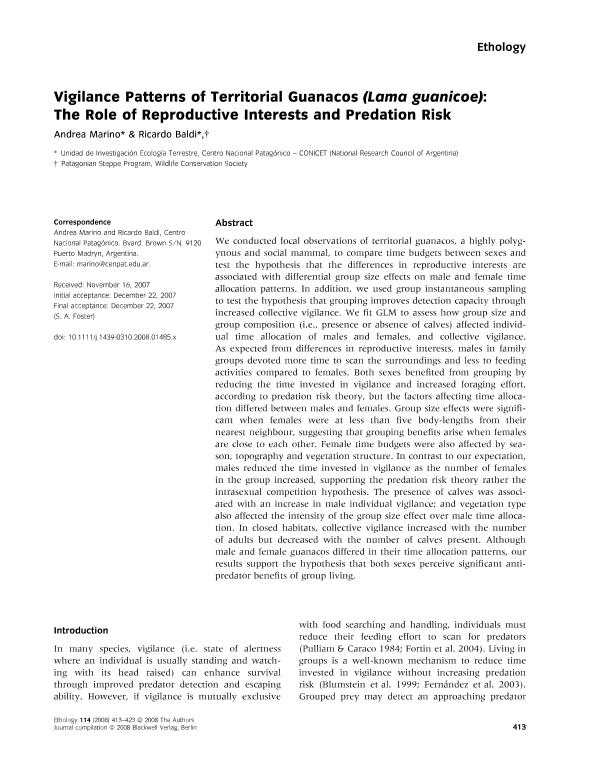Mostrar el registro sencillo del ítem
dc.contributor.author
Marino, Andrea Ivana

dc.contributor.author
Baldi, Ricardo

dc.date.available
2020-01-27T17:20:16Z
dc.date.issued
2008-12
dc.identifier.citation
Marino, Andrea Ivana; Baldi, Ricardo; Vigilance patterns of territorial guanacos (Lama guanicoe): The role of reproductive interests and predation risk; Wiley Blackwell Publishing, Inc; Ethology; 114; 4; 12-2008; 413-423
dc.identifier.issn
0179-1613
dc.identifier.uri
http://hdl.handle.net/11336/95836
dc.description.abstract
We conducted focal observations of territorial guanacos, a highly polygynous and social mammal, to compare time budgets between sexes and test the hypothesis that the differences in reproductive interests are associated with differential group size effects on male and female time allocation patterns. In addition, we used group instantaneous sampling to test the hypothesis that grouping improves detection capacity through increased collective vigilance. We fit GLM to assess how group size and group composition (i.e., presence or absence of calves) affected individual time allocation of males and females, and collective vigilance. As expected from differences in reproductive interests, males in family groups devoted more time to scan the surroundings and less to feeding activities compared to females. Both sexes benefited from grouping by reducing the time invested in vigilance and increased foraging effort, according to predation risk theory, but the factors affecting time allocation differed between males and females. Group size effects were significant when females were at less than five body-lengths from their nearest neighbour, suggesting that grouping benefits arise when females are close to each other. Female time budgets were also affected by season, topography and vegetation structure. In contrast to our expectation, males reduced the time invested in vigilance as the number of females in the group increased, supporting the predation risk theory rather the intrasexual competition hypothesis. The presence of calves was associated with an increase in male individual vigilance; and vegetation type also affected the intensity of the group size effect over male time allocation. In closed habitats, collective vigilance increased with the number of adults but decreased with the number of calves present. Although male and female guanacos differed in their time allocation patterns, our results support the hypothesis that both sexes perceive significant antipredator benefits of group living.
dc.format
application/pdf
dc.language.iso
eng
dc.publisher
Wiley Blackwell Publishing, Inc

dc.rights
info:eu-repo/semantics/openAccess
dc.rights.uri
https://creativecommons.org/licenses/by-nc-sa/2.5/ar/
dc.subject
BEHAVIOUR
dc.subject
GUANACOS
dc.subject
PREDATION RISK
dc.subject
VIGILANCE PATTERNS
dc.subject.classification
Otras Ciencias Agrícolas

dc.subject.classification
Otras Ciencias Agrícolas

dc.subject.classification
CIENCIAS AGRÍCOLAS

dc.title
Vigilance patterns of territorial guanacos (Lama guanicoe): The role of reproductive interests and predation risk
dc.type
info:eu-repo/semantics/article
dc.type
info:ar-repo/semantics/artículo
dc.type
info:eu-repo/semantics/publishedVersion
dc.date.updated
2019-12-12T14:50:47Z
dc.journal.volume
114
dc.journal.number
4
dc.journal.pagination
413-423
dc.journal.pais
Reino Unido

dc.journal.ciudad
Londres
dc.description.fil
Fil: Marino, Andrea Ivana. Consejo Nacional de Investigaciones Científicas y Técnicas. Centro Nacional Patagónico; Argentina
dc.description.fil
Fil: Baldi, Ricardo. Consejo Nacional de Investigaciones Científicas y Técnicas. Centro Nacional Patagónico; Argentina. Wildlife Conservation Society; Estados Unidos
dc.journal.title
Ethology

dc.relation.alternativeid
info:eu-repo/semantics/altIdentifier/doi/https://doi.org/10.1111/j.1439-0310.2008.01485_1.x
dc.relation.alternativeid
info:eu-repo/semantics/altIdentifier/url/https://onlinelibrary.wiley.com/doi/abs/10.1111/j.1439-0310.2008.01485_1.x
Archivos asociados
